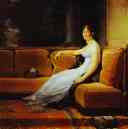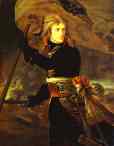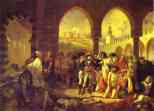Napoleon I, Emperor of France
 Napoleon
I, or Napoleon Bonaparte was born in Ajaccio, Corsica, second son of Charles-Marie
Bonaparte (1746-1785) and Letizia Ramolino (1750-1836). He had one elder
brother and 6 younger sisters and brothers: Joseph
Bonaparte (1768-1844), Lucien Bonaparte (1775-1840), Elisa Bonaparte
(1777-1820), Louis Bonaparte (1778-1846), Pauline Bonaparte (1780-1825),
Caroline
Bonaparte (1782-1839) and Jérôme Bonaparte (1784-1860).
Napoleon
I, or Napoleon Bonaparte was born in Ajaccio, Corsica, second son of Charles-Marie
Bonaparte (1746-1785) and Letizia Ramolino (1750-1836). He had one elder
brother and 6 younger sisters and brothers: Joseph
Bonaparte (1768-1844), Lucien Bonaparte (1775-1840), Elisa Bonaparte
(1777-1820), Louis Bonaparte (1778-1846), Pauline Bonaparte (1780-1825),
Caroline
Bonaparte (1782-1839) and Jérôme Bonaparte (1784-1860).
Granted free military education in France, Napoleon Bonaparte studied
French at Autun before entering the military schools at Brienne (1779)
and Paris (1784). In 1785, he was commissioned second lieutenant
of artillery in the regiment of la Fère, garrisoned at Valence.
At Auxonne he saw the beginnings of the French Revolution, but, more concerned
with Corsica than France, he went home on leave to organize a revolution
and was temporarily struck off the army list for returning to his regiment
late (1792).
A year later he was given command of the artillery at the siege of
Toulon (1793) and was promoted to a brigadier general.
After the fall of Robespierre, Napoleon was arrested on a charge of
conspiracy because of his friendship with the younger Robespierre, but
the charges were not proven and he was released.
 In
1795, he helped to defeat supporters of the counter-revolution in Paris
with the celebrated ‘whiff of grapeshot’ against the mob at the Tuileries,
and was then appointed commander of the army in Italy (1796). Two days
before his departure for Italy he married Joséphine,
widow of General Vicomte de Beauharnais.
In
1795, he helped to defeat supporters of the counter-revolution in Paris
with the celebrated ‘whiff of grapeshot’ against the mob at the Tuileries,
and was then appointed commander of the army in Italy (1796). Two days
before his departure for Italy he married Joséphine,
widow of General Vicomte de Beauharnais.
On arrival in Nice he was appalled by the poverty and lack of discipline
of the French army. In the Italian campaign Napoleon was able to demonstrate
his great military genius. Since his army was outnumbered by the combined  Piedmontese-Austrian
forces he was determined to separate them. He finally routed the Piedmontese
at Mondovi, after which Sardinia asked for peace, and the Austrians at
Lodei, after which he entered Milan. He next broke through the Austrian
center and occupied the line of Adige, taking Verona and Legnago from the
neutral republic of Venice. Austria made attempts to recover Lombardy,
but she was defeated at Arcola and Rivoli.
Piedmontese-Austrian
forces he was determined to separate them. He finally routed the Piedmontese
at Mondovi, after which Sardinia asked for peace, and the Austrians at
Lodei, after which he entered Milan. He next broke through the Austrian
center and occupied the line of Adige, taking Verona and Legnago from the
neutral republic of Venice. Austria made attempts to recover Lombardy,
but she was defeated at Arcola and Rivoli.
When Napoleon’s position in Italy was secured he advanced on Vienna, and reached Leoben in April 1797. Negotiations for a peace settlement with Austria began, but progressed slowly as Austria hoped to benefit from the political crisis in France, where the moderates and royalists were gaining power on the legislative councils. Napoleon, however, dispatched General Augereau to assist the Directory in disposing of their opponents by force.
In October 1797, Austria signed the Treaty of Campo Formio, by which
France obtained Belgium, the Ionian Islands and Lombardy, while Austria
got Istria, Dalmatia and Venice and engaged to try to get the left bank
of the Rhine for France.
The Directory, fearing Napoleon’s power and ambition, hoped to keep
him away from Paris by giving him command of the army that was going to
invade England. But, realizing the folly of invading England while her
fleet was supreme, he set out on an expedition to Egypt in the hope of
damaging Britain’s trade with India.
 Napoleon
set sail in May 1798, captured Malta and, escaping the British fleet, arrived
at Alexandria on 30 June. He then twice defeated the Mamelukes and entered
Cairo on 24 July, but his position was endangered by the destruction of
the French fleet on 1 August by Nelson at the battle of the Nile. He defeated
the Turks at Mount Tabour but failed to capture St Jean d’Acre, defended
by the British squadron under Sir Sidney Smith, and was obliged to return
to Egypt. He defeated a Turkish army, which had landed at Aboukir, but
learning of French reverses in Italy and on the Rhine, he secretly embarked
for France on 22 August 1799.
Napoleon
set sail in May 1798, captured Malta and, escaping the British fleet, arrived
at Alexandria on 30 June. He then twice defeated the Mamelukes and entered
Cairo on 24 July, but his position was endangered by the destruction of
the French fleet on 1 August by Nelson at the battle of the Nile. He defeated
the Turks at Mount Tabour but failed to capture St Jean d’Acre, defended
by the British squadron under Sir Sidney Smith, and was obliged to return
to Egypt. He defeated a Turkish army, which had landed at Aboukir, but
learning of French reverses in Italy and on the Rhine, he secretly embarked
for France on 22 August 1799.
Sieyès, one of the Directors, realizing the unpopularity and weakness of the government, was considering a coup d’état when Napoleon arrived. They coalesced, despite their distrust of each other, and the revolution of the 18th Brumaire followed (9 November 1799), Sieyès, Roger Ducos and Napoleon drew up a new constitution. Under it the executive power was entrusted to three consuls, Napoleon, Cambacérès and Lebrun, of whom Napoleon was nominated the first consul for ten years.
Before embarking on military campaigns Napoleon had to improve the perilous
state of the French Treasury. He made plans to found the Bank of France,
stabilize the franc and regulate the collection of taxes by employing paid
officials; he also tried to improve the system of local government and
the judicial system which had become very lax during the years of the revolution.
He made offers of peace negotiations to England and Austria but was not
surprised when these were rejected.
While Masséna occupied the attention of the Austrian general
Mélas in Piedmont, Napoleon secretly collected an army, reached
the plains of Italy, and occupied Milan. In June 1800, the Austrians were
routed at Marengo. Napoleon returned to Paris to disprove the rumors about
his defeat and death. Moreau’s victory at Hohenlinden (1800) led to the
signing of the Treaty of Luneville (February 1801) by which the French
gains of the Campo Formio treaty were reaffirmed and increased.
France’s power in Europe was further consolidated by the Concordat
with Rome by which Pope Pius VII recognized the French Republic and by
the peace of Amiens with war-weary England (1802). By this treaty England
was allowed to retain Ceylon and Trinidad but relinquished Egypt, Malta
and the Cape of Good Hope; France agreed to evacuate Naples; the independence
of Portugal and the Ionian Islands was recognized.
Napoleon then continued his domestic reforms: he restored the church,
realizing that many people, especially the peasants, felt need of religion;
he made an effort to improve secondary education; and he instituted the
Legion of Honor (Légion d’Honneur). He was elected first consul
for life.
Peace between England and France did not last long because Napoleon
annexed Piedmont, occupied Parma and interfered in Swiss internal affairs,
and because Britain refused to give up Malta, Napoleon made vast preparations
for the invasion of England, at the same time seizing Hanover. England
sent help to the royalist conspirators led by Cadoudal, who was plotting
against Napoleon’s life, but Napoleon arrested the conspirators and rid
himself of Moreau, his most dangerous rival, by accusing him of conspiring
with the royalists. He also executed the Duc d’Enghien, a young Bourbon
prince, although his connection with the conspirators was not proved.
 On
18 May 1804, Napoleon assumed the hereditary title of emperor because France
did not want to be left without a rightful leader in the event of his death.
On
18 May 1804, Napoleon assumed the hereditary title of emperor because France
did not want to be left without a rightful leader in the event of his death.
In 1805, Napoleon found himself at war with Russia and Austria, as
well as with England. England’s naval supremacy forced him to abandon the
idea of invasion, and he suddenly, in August 1805, led his armies from
Boulogne to the Danube, leaving Villeneuve to face the English fleet. He
succeeded in surprising the Austrians under Mack at Ulm and they surrendered
(19 October), leaving him free to enter Vienna on 13 November.
On 2 December 1805 Napoleon inflicted a disastrous defeat on the Russians
and Austrians at Austerlitz. The Holy Roman Empire came to an end, the
Confederation of the Rhine was formed under French protection, and Napoleon
then entered into negotiations for peace with Russia and England.
Prussia, afraid that an Anglo-French alliance would mean the loss of Hanover to England, mobilized her army in August 1806; but Napoleon crushed it at Jena and Auerstadt on 14 October. Russia, who had intervened, was defeated at Friedland on 14 June 1807.
By the peace of Tilsit Prussia lost half her territory and Napoleon was now the arbiter of Europe. Knowing England’s reliance on her trade Napoleon tried to cripple her by the Continental System, by which he ordered the European states under his control to boycott British goods. He sent an army under Junot to Portugal, which refused to adhere to the Continental System, another under Murat, to Spain because he was uncertain of her loyalty. When he placed his brother Joseph Napoleon on the Spanish throne many of the nobles and clergy rebelled against the French, while a British army, under Wellesley (Wellington), landed in Portugal, defeated Junot at Vimeiro (1808) and forced him to evacuate Portugal under the terms of the Convention of Cintra. Thus began the Peninsular War, which was to occupy a large part of the French army until 1813 when Wellington routed the French and forced them out of Spain.
 In
1809, Austria took advantage of the French troubles in Spain to declare
war on France. Napoleon drove the Austrians out of Ratisbon, and entered
Vienna on 13 May, then won the battle of Wagram on 5 and 6 July. By the
treaty of Schönbrunn (20 October 1809) France obtained from Austria
the Illyrian provinces, and a heavy money indemnity.
In
1809, Austria took advantage of the French troubles in Spain to declare
war on France. Napoleon drove the Austrians out of Ratisbon, and entered
Vienna on 13 May, then won the battle of Wagram on 5 and 6 July. By the
treaty of Schönbrunn (20 October 1809) France obtained from Austria
the Illyrian provinces, and a heavy money indemnity.
In December 1809, Napoleon, desirous of an heir, divorced Joséphine, who had failed to give him a child, and married the archduchess Marie Louise of Austria. A son, the future Napoleon II, was born on 20 March 1811.
 Still
bent on the humiliation of England, Napoleon soon increased the stringency
of the Continental System, and annexed Holland and Westphalia. Russia opened
its ports to neutral shipping, and this convinced Napoleon that the tsar
was contemplating alliance with England. He
decided to invade Russia and teach her a lesson. He narrowly defeated the
Russians at Borodino on 6 September 1812, after that battle the Russians
retreated and left him free to enter Moscow, which Napoleon found deserted
and which was destroyed by the fires that broke out the next night (read
more in The Great Fire in Moscow).
He was then forced to retreat from Moscow, his army hungry, encumbered
by the sick and wounded and suffering from the effects of the Russian winter,
which he had underestimated. Only a mere fraction of the Grand Army that
had set out for Russia reached Vilna.
Still
bent on the humiliation of England, Napoleon soon increased the stringency
of the Continental System, and annexed Holland and Westphalia. Russia opened
its ports to neutral shipping, and this convinced Napoleon that the tsar
was contemplating alliance with England. He
decided to invade Russia and teach her a lesson. He narrowly defeated the
Russians at Borodino on 6 September 1812, after that battle the Russians
retreated and left him free to enter Moscow, which Napoleon found deserted
and which was destroyed by the fires that broke out the next night (read
more in The Great Fire in Moscow).
He was then forced to retreat from Moscow, his army hungry, encumbered
by the sick and wounded and suffering from the effects of the Russian winter,
which he had underestimated. Only a mere fraction of the Grand Army that
had set out for Russia reached Vilna.
Alexander I, incited by England and royal emigrants in St. Petersburg,
was only eager to continue the war on the territory of Europe. Napoleon,
leaving the remains of the army to Murat, hurried to Paris to raise new
levies, stem the rising panic and disprove rumors of his death.
Meanwhile the Prussian and Austrian contingents withdrew from the Grand
Army. Prussia and Saxony allied with Russia, but Austria and the middle
states doubted the ability of the allies to defeat Napoleon and disliked
the idea of alliance with Russia.
Napoleon left Paris on 15 April 1813, moved on Leipzig, and won the
battle of Lützen on 2 May. He then followed the allies, beat them
at Bautzen, on 20 and 21 May, and forced them to retire into Silesia. Austria
then asked for concessions of territory; but he merely offered to concede
Illyria to them, and Austria joined the allies. Napoleon inflicted a crushing
defeat on the Austrians near Dresden but part of the French army under
Vandamme was forced to surrender at Kulm.
In October 1813, Napoleon was defeated at Leipzig and led back the
remnant of his army across the Rhine. The invasion of France followed the
rejection of peace terms, which deprived France of much of her territorial
conquests. Napoleon won four battles in four days at Champaubert, Montmirail,
Vauchamps and Montereau but benefited little from the battles of Craonne
and Laon, which followed.
On 30 March 1814, the allies attacked Paris, and Marmont signed the
capitulation of Paris. Napoleon fell back to Fontainebleau; but his position
was desperate and Wellington had now led his army across the Pyrenees into
France. The French marshals forced him to abdicate, first in favor of his
son, then unconditionally (11 April).
By the treaty of Fontainbleau Napoleon was given the sovereignty of Elba, allowed to retain the title of emperor, and awarded a revenue from the French government. The Bourbons in the person of Louis XVIII were restored to the throne of France, but their return was unpopular. The army was disgusted at their treatment by the king and also at the appointment to commands of émigrés who had fought against France, and alarm was caused by proposals to return national lands to the émigrés and the church. The coalition, too, broke up because of quarrels over territorial settlement, especially over Prussia.
Napoleon hoped to take advantage of the situation and landed on the
French coast on 1 March 1815. On the 20th he entered Paris at the start
of the ‘Hundred Days’, having been joined by the army. Europe had declared
war against him but only a mixed force under Wellington in Belgium and
a Prussian army under Blücher in the Rhine provinces were in the field.
Napoleon’s aim being to strike suddenly and to defeat each force separately,
he occupied Charleroi and, on 16 June defeated Blücher at Ligny. But
not until the next day did he send Grouchy to follow the retreating Prussians,
thus enabling Blücher to move on the Wavre to join Wellington who
had retired to Mont St Jean, while Grouchy was engaged with the Prussian
rearguard only.
On 18 June 1815, the famous battle of Waterloo took place. After his
defeat by Wellington and Blücher, Napoleon fled to Paris, abdicated
on 22 June, decided to throw himself on the mercy of England, and surrendered
to Captain Maitland of the Bellerophon at Rochefort on 15 July 1815.
Napoleon was banished by the British government to St. Helena, where
he died on 5 May 1821. Whether he was poisoned or died of natural causes
is another more historical
mystery.
See: Jacques-Louis David.
Bonaparte
Crossing the St. Bernard Pass. Napoleon
in His Study.
François-Pascal-Simon Gérard.
Marie-Louise,
Empress of France with Her son Napoleon II, King of Rome.
Anne-Louis Girodet de Roussy-Trioson. Napoleon
in Coronation Robes.
Antoine-Jean Gros.
Napoleon at
Arcola. Napoleon at Arcola.
The Battle at Arcola (Italy) took place on 15-17 November 1796. Twenty
nine thousand French army under Napoleon defeated the eighty thousand Austrian
army. One of the vivid and decisive moments of the battle was the fight
for the Arcole Bridge. The French stormed it in attacks several times,
and each time failed. Then Napoleon took a flag and led the next attack
in person. The Arcole Bridge was taken and that decided the result of the
whole battle.
Antoine-Jean Gros.
Napoleon on
the Battlefield at Eylan, February 9, 1807. Bonaparte
Visiting the Plague-Striken at Jaffa on 11 March 1799.
Jean-Auguste-Dominique Ingres. Portrait
of Napoléon Bonaparte, The First Council.
Napoleon donated 300,000 francs to Liege for reconstruction of the
suburb d’Amercoeur, which was destructed by Austrians in 1794. The painting
was added to be hanged in the City Hall to commemorate the gift. Napoleon
sat for Ingres only once for a sketch, and the artist had to do the whole
work by memory.
Jean-Auguste-Dominique Ingres. Portrait
of Napoléon on the Imperial Throne.
Vasily Vereshchagin. Napoleon
in the Petroff Palace., Napoleon
and Marshal Loriston ("Peace at all costs!")., Napoleon
I on the Borodino Hights.
Napoleon II, properly François
Charles Joseph Bonaparte (1811-1832) son of Napoleon I by Marie Louise,
born in Paris. He was styled king of Rome upon his birth at the Tuileries
in 1811. From 1814 until his death (from tuberculosis) he lived at the
Austrian court and was created Duke of Reichstadt (1818) by his grandfather,
Francis I. Loyal Bonapartists proclaimed him Napoleon II in Paris on 28
June 1815, but he was formally deposed five days later. He spent the rest
of his life in Vienna.
See: François-Pascal-Simon Gérard. Marie-Louise,
Empress of France with Her son Napoleon II, King of Rome.
Pierre-Paul Prud'hon. The
King of Rome.
Bibliography:
Chambers Biographical Dictionary. Chambers. 1996.
Napoleon Bonaparte. by S. Burin. Smolensk. 1999.
Napoleon I in Russia. by V. Vereshchagin. Tver. 1993.
Borodino. 1812. Moscow. 1987.
Napoleon’s Invasion of Russia. 1812. by E.V. Tarle. Phenix.
1994.
Borodino. by E.V. Tarle. Phenix. 1994.
Napoleon. by E.V. Tarle. Phenix. 1994.
My Brother Napoleon: the Confessions of Caroline Bonaparte by
Frank Wilson Kenyon. Hutchinson;
Napoleon:
(Penguin Lives Series) by Paul Johnson. Viking Press, 2002.
Napoleon
by Frank McLynn. Arcade Publishing, 2002.
Campaigns
of Napoleon: The Mind and Method of History's Greatest Soldier
by David G. Chandler. Simon & Schuster, 1973.
A
Military History and Atlas of the Napoleonic Wars by Vincent
J. Esposito, John R. Elting. Greenhill Books/Lionel Leventhal, 1999.
The
Reign of Napoleon Bonaparte by Robert Asprey. Basic Books,
2001.
The Rise of Napoleon Bonaparte by Robert B. Asprey. Basic Books,
2000.
Napoleon's
Mercenaries: Foreign Units in the French Army Under the Consulate and Empire,
1799-1814 by Guy C., Jr Dempsey. Greenhill Books/Lionel Leventhal,
2002.
The
Waterloo Companion: The Complete Guide to History's Most Famous Land Battle
by Mark Adkin. Stackpole Books, 2002.
With
Napoleon in Russia: The Illustrated Memoirs of Faber Du Faur, 1812
by Christian Wilhelm Von Faber Du Faur, Jonathan North. Greenhill Books/Lionel
Leventhal, 2001.
Bussaco
1810: Wellington Defeats Napoleon's Marshals by Rene Chartrand,
Patrice Courcelle (Illustrator). Osprey Pub Co, 2001.
1813,
Leipzig: Napoleon and the Battle of the Nations by Digby George
Smith. Greenhill Books/Lionel Leventhal, 2001.
Borodino-The
Moskova: The Battle for the Redoubts by F. G. Hourtoulle. Histoire
& Collections, 2001.
BORODINO
1812; Revisiting Napoleon's Bloodiest Day -- Napoleon Journal #14
by Matt Delamater (Editor), Gilberto Villahermosa. Stackpole Books, 2001.
NAPOLEON
IN SYRIA; Field Marshal Suvorov Retakes Italy in 1799 -- Napoleon Journal
#15 by Matt Delamater (Editor), Christopher Duffy (Illustrator),
John Pomeroy (Illustrator), Steven Palatka (Illustrator), Keith Rocco,
Ray Rubin. Stackpole Books, 2001.